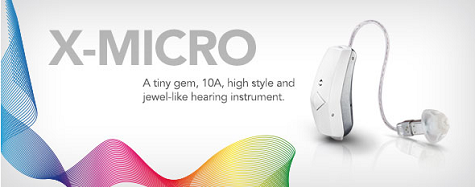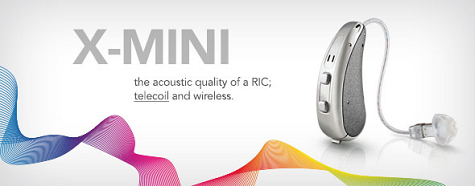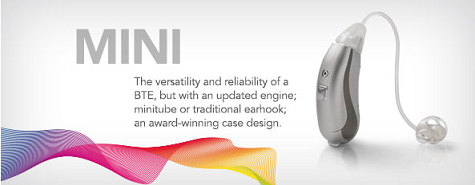Interview with Jerry Yanz, PhD and Margaret Bandkau, MBA, MA Audiologist, Hansaton
Carolyn Smaka: Thanks for your time today, Jerry and Margaret. Can we start with an overview of Hansaton’s new XearA platform?

Margaret Bandkau: XearA is the most innovative chip available in the industry right now, in terms of speed, processing and capabilities. It is smarter, faster and more accurate, and sets the foundation for a number of new and improved digital algorithms. This is a significant leap forward in digital technology from what we have seen in recent years, with many benefits for consumers.
Carolyn: How does this platform translate into features?

Jerry Yanz: I’ll provide a few highlights. The high processing speed provides extended bandwidth out to 10 kHz and hi-fidelity sound in the top two technology levels. Although the difference is small visually on a response graph due to receiver roll off, when you listen to it you will hear a big difference.
We have also added a completely new compression architecture with two compression thresholds and two compression ratios, instead of one. Adjustments can be made in up to 18 channels, giving us the ability to fine-tune the dynamic range of the instrument to the compromised dynamic range of the impaired ear. In short, it does a better job than ever of achieving the traditional wide dynamic range compression (WDRC) goals of making soft sounds audible, average sounds comfortable, and loud sounds loud, but not too loud.
Carolyn: How does this perform for the dynamic user who is in many different listening/sound environments?
Margaret: This platform is highly accurate in categorizing the acoustic environment. One example is with Speech Beam, which enables the directional beam to follow the primary speech input, even when that input comes from the rear. In the first-class technology level, Speech Beam is automatic. For example, if the wearer is driving a car, it recognizes the environment, and optimizes the maximum response angle of the directional system to find the primary speech input, while reducing car noise and road noise. This enables the wearer to hear the passenger, whether the passenger is in the front or back seat.
I have been wearing one of our new products for about a month now and I love it. When I am training, I tell people that I can go from a meeting to the car to dinner, and this processing is seamless. It is seamless because of how accurately and quickly it responds to the environment.
Jerry: Cars are traditionally very difficult environments for hearing aids, but the XearA platform can make this distinction based on the spectral shape of the noise in the car. The ability to categorize acoustic inputs goes beyond the car, however. We have data showing that it will categorize speech in quiet, speech in noise, noise alone, music, or the car, and the accuracy of categorization is typically in the mid-80% range. This is extremely high for categorizing those environments, and then it makes its adjustments accordingly.
The first program in these multi-program instruments has always been called the universal program, even in our previous technology. With the XearA platform, the universal program is more universal than ever before.
We have up to six programs to use, but our philosophy is to make the universal program so agile in responding that you will rarely need all of the other programs. We want to keep it simple for the end user.
Carolyn: What does the XearA platform offer for feedback?
Jerry: The feedback canceller in our previous technology is called the Active Feedback Block. Research comparing it to other systems on the market by measuring real ear insertion gain as a function of frequency has shown it to be among the best. The new feedback algorithm, which is called Feedback X, builds on the performance of the earlier version and makes it even better. There are a number of different things going on in the feedback canceller, including the introduction of an inaudible phase-modulated acoustic marker to help the digital signal processor (DSP) identify what incoming signal is feedback and what incoming signal is a desirable input. In addition to that, there is a slight frequency shift to disrupt the feedback path. The frequency shift is adaptive in this system, which is a new feature. It will be a larger or smaller frequency shift depending on the incoming signal.
One additional feature is Open X. This is specifically for open fittings that have become so popular in recent years. It adds another layer of processing to deal specifically with high-level feedback radiating directly out of an open ear canal and back to the hearing aid microphone. On top of that, there are three different levels of aggressiveness of this feedback system. We continue to make progress toward the complete obliteration of feedback in hearing aids.
Carolyn: Are there additional features that make this platform unique?
Margaret: I would like to highlight Conversation Lift. Conversation Lift pulls speech out of background noise, while simultaneously diminishing the surrounding background noise.
There are a couple of different algorithms working together to accomplish that. Conversation Lift works in tandem with our multichannel adaptive directional algorithm. The directional algorithm identifies the location of the primary speech input. Then Conversation Lift steps in and adds some further processing to quell the noise and enhance the speech, regardless of the azimuth of the speech.
While typical directional benefit is on the order of 3 dB, Conversation Lift raises that benefit to 7 dB. As always, directional benefit in dB is numerically small, its impact on hearing in noise is very large, and this system makes it even greater.
Carolyn: Can you tell me how these features play out among the First Class Antaro, Business Class Inara; and Comfort Class Sorino products?
Jerry: The three technology levels you mentioned are available in each of three models in the new XearA line. The first, which we introduced in January, is X-Micro, a 10A receiver-in-the-canal (RIC). It is a beautiful, tiny hearing aid. While the small battery necessarily limits battery life, power management circuitry minimizes that effect. I like to describe the X-Micro as the hearing aid for someone who comes into the office looking for jewelry but needing hearing help.

X-Micro hearing aid
More recently, we have added another RIC, the X-Mini, with a 312 battery, which offers the benefit of having both a telecoil and wireless capabilities to synchronize binaural processing and enable Bluetooth connectivity. We have also added a behind-the-ear (BTE) called the Mini, which is adaptable to either a traditional earhook and earmold or the popular mini-tube fitting.

X-Mini hearing aid

Mini-BTE hearing aid
Margaret: We now have three styles in each technology: First Class, Business Class, and Comfort Class.
Carolyn: Any updates to your rechargeable AQ custom products?
Jerry: Both the AQ X-Mini RIC and the AQ Custom Rechargeables have gone through some evolution in the last year. There have been upgrades to improve the performance, reliability and stability of the charging system. It was the best rechargeable available a year ago, and now it is has gotten even better. Next month, the XearA platform will be available in all of our custom products, including the AQ rechargeables.
We are still a small player in the United States market, and we intend to remain that way. That is one thing that gives us more personalized treatment and service than you would typically get from a very large manufacturer.
We have also seen some important evolution in our custom lab, adding capabilities that exceed the expectations of a small manufacturer. Our new digital light manufacturing system for custom shells goes a step beyond laser technology in the 3D printing process. By digitally modeling ear impressions and all circuit components, we can build the hearing aid with all of its parts virtually on the computer screen. Only then is the actual physical shell rendered, which guarantees that all the parts will fit well. We are also downsizing components, and the custom instruments coming out of this process are very attractive and have been very well received in the market. This applies to both the AQ rechargeables and all of our conventional custom aids. I enjoy hearing all the positive feedback from professionals who have used our custom products over time and have seen the changes.
Carolyn: For professionals who want to get updated on the new platform and products, and receive training, where should we direct them?
Margaret: They can call the toll-free number at Hansaton (888-984-7432) and contact us directly. We offer free online training and other options to best meet the needs of professionals.
Carolyn: There is certainly a lot going on at Hansaton! Thanks again for your time today.
For more information, please visit the Hansaton Expo on AudiologyOnline, contact Hansaton at 888-984-7432 or visit www.hansaton-usa.com


